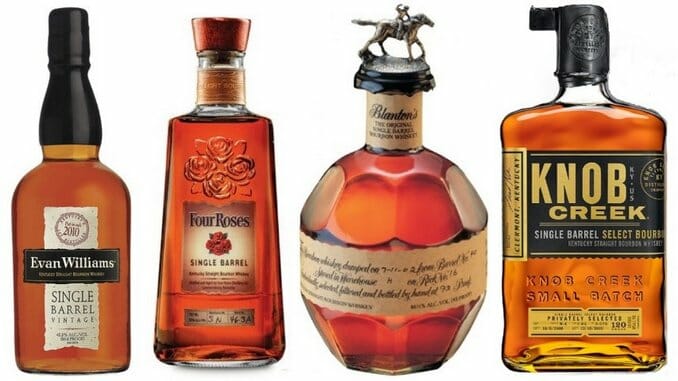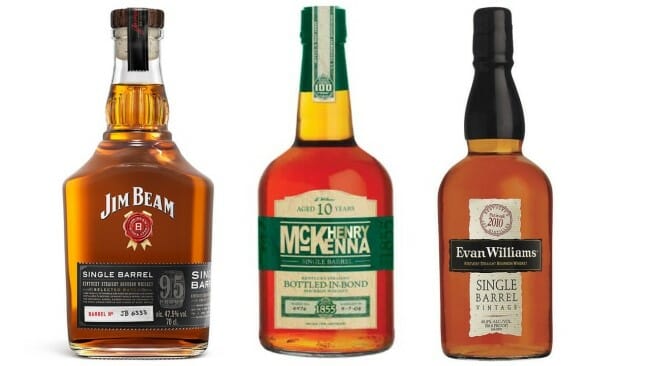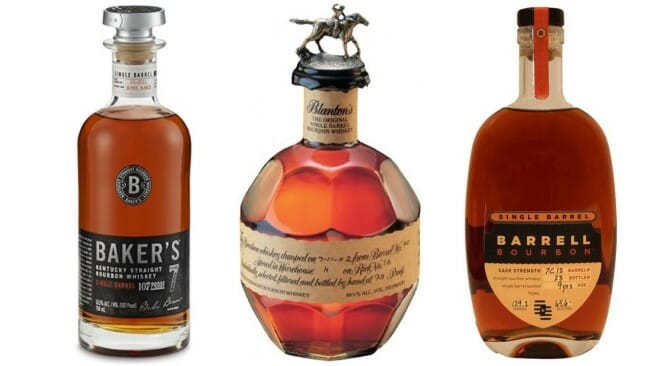
Cocktail Queries is a Paste series that examines and answers basic, common questions that drinkers may have about mixed drinks, cocktails and spirits. Check out every entry in the series to date.
Single barrel bourbon. It sounds inherently fancy, does it not? The word “single,” all on its own, implies a certain luxe status within the whiskey world, owing to the fact that single malt scotches are regularly more expensive than blended scotch whiskies—an obvious topic for another Cocktail Queries entry.
But what should a consumer be expecting, when they see the words “single barrel” on a bottle of bourbon or rye whiskey? How much should they cost? How strong will they be? What else sets the category apart? Let’s get into it and answer these questions.
What Is Single Barrel Bourbon?
First up: A simple definition of what the term means in general. “Single barrel,” exactly as the name would imply, means that that bottle does indeed contain whiskey from only one barrel. This seems like it might be the normal mode of operation for distilleries at first glance, but the opposite is true. And it’s because of consistency.
When a company like Jim Beam creates a batch of a flagship bourbon like Jim Beam White Label, they need it to taste exactly like the previous batch, and this is impossible when simply bottling the contents of individual barrels. An incredible array of different chemical processes are happening in any given barrel of whiskey, which will directly affect maturation speed, flavor profiles, degree of evaporation and more. Something as seemingly simple as how high a whiskey barrel is in a rickhouse has a major effect on temperature control and evaporation, which likewise affects flavor by controlling how deeply the whiskey is drawn into the wood of the barrel. In order to achieve consistency, then, a company like Beam blends many barrels into massive batches, until they’ve created something that tastes exactly like previous batches.
As you scale back the number of barrels in a batch, however, you invite more unique flavors. This is where we get “small batch” bourbons—we recently wrote more about this category as well—such as Elijah Craig, Four Roses Small Batch, or 1792 Small Batch, which are implied to have more subtle variations from batch to batch. The fewer barrels, the more unique each batch is likely to be. Some former single barrel bourbons, such as Eagle Rare and Willett Pot Still Reserve, now fall into this category after losing their single barrel status.
 Two bourbons that were formerly single barrel, but are now small batch instead.
Two bourbons that were formerly single barrel, but are now small batch instead.
Single barrel bourbons, then, take this concept to its logical extreme. Two separate barrels of the same bourbon can be extremely different from one another, even given the same mash bill, yeast and maturation time. Bourbon geeks will hunt for the “best” single barrels of various brands, referring to them as “honey barrels”—those that capture some ephemeral, perfect quality that exemplifies the brand. Whiskey bars and package stores also get into the game by tasting and buying the contents of entire barrels in order to have their own private single barrel releases that no other competitor can replicate. Even clubs of private whiskey buyers will purchase single barrels, splitting the resulting bottles between their members. The allure is the mystery of not knowing quite how any given single barrel will differ. As a result, they’re something of a gamble—you might well find that you like one barrel of a certain brand, but not another.
Single barrel bourbon brands, however, also differ in many other ways. For one, the amount of bottles yielded by a standard, 53-gallon barrel will vary wildly based on several factors: How old they are, how much spirit has evaporated, and what proof the liquid is eventually watered down to before bottling. At the high end, this can yield more than 220 bottles of standard strength bourbon. At the low end, you could end up with as few as 130 bottles of well-aged, cask-strength bourbon.
As a result, bottles of single barrel bourbon are available in a wider range of prices than you might expect—just because a bourbon is “single barrel” doesn’t necessarily mean it’s particularly expensive. Likewise, they can range from the minimum federal strength of 80 proof (though this is rare), all the way through cask strengths of 130 or 140 proof. Ultimately, the single barrel category is almost as broad as the bourbon category itself.
Entry Level, Mid-Shelf and Splurgy Single Barrel Bourbons
To illustrate the wide range of single barrel bourbons on the market, let’s examine some of the common brands you might be able to purchase within three different price ranges: entry level, mid-shelf and splurge.
Entry Level Single Barrel Bourbons (roughly $25-40)

This is actually a more robust category than you might think, as many of the old-school Kentucky producers have affordable single barrel bourbon brands that could be thought of as upgraded versions of their flagships. These are often bottled at slightly higher proofs than the flagship bourbons, but the proofs are still lower than more expensive single barrel bourbons. This description includes something like Jim Beam Single Barrel, at 95 proof, or Evan Williams Single Barrel at a mere 86.6 proof. The latter carries a higher average age than the flagship Evan Williams black label, and with price tags as low as $25 is one of the best values available in single barrel bourbon.
Also from Heaven Hill is Henry McKenna 10 Year Single Barrel, which was until recently a sleeper and excellent value in the single barrel category. Several high-profile awards, however, have led to prices on that particular bourbon being jacked up, which is a phenomenon you’ll unfortunately encounter in single barrel bourbon on a fairly regular basis. You may still be able to find it under $40, but gone are the days when it was truly undervalued.
Mid-Shelf Single Barrel Bourbons (roughly $40-60)

Many of the most common single barrel bourbons on the market will be found in this range, as this price point allows for both a decent amount of age and a robust proof, which may even approach cask strength. Many of the bottles here are suitable year round as gifts for the whiskey geek in your life—especially if they’re unique store picks. A word to the wise: People who are into whiskey tend to love store picks of single barrel bourbon, because they represent a dram that will almost certainly be unique in some way.
Stalwarts of the single barrel bourbon mid-shelf would include Jim Beam’s Knob Creek Single Barrel, weighing in at a meaty 120 proof, and also the likes of Russell’s Reserve Single Barrel, 1792 Single Barrel, Old Forester Single Barrel, Wild Turkey Kentucky Spirit, Michter’s Single Barrel Rye and even Jack Daniel’s Single Barrel. You’ll also likely see some younger bourbons from smaller craft distilleries in the mix in this price range, such as the fast-rising New Riff Single Barrel.
Perhaps of special interest here is something like Four Roses Single Barrel Bourbon, as this company is specifically associated with single barrel releases. Because the flagship Four Roses is unique among bourbons, being a blend of 10 separate bourbon recipes (2 mash bills, 5 yeast strains), the company also bottles all 10 recipes as single barrel bourbon releases. However, only one of the 10 recipes (known as OBSV) is available as the standard, commercially available Four Roses Single Barrel, packaged at 100 proof. The other 9 recipes can only be obtained as store picks and special releases, and are bottled at cask strength! That makes tracking down rarer varieties, such as “OBSQ” or “OESF” the geeky pastime of many bourbon geeks. Be sure to check the tags of Four Roses Single Barrel bottles for this reason.
Splurgy Single Barrel Bourbons ($60 and far beyond)

Unfortunately for the integrity of one’s wallet, there are indeed a lot of single barrel bourbons that far exceed the $60 mark. Most of these will have large age statements or be close to cask strength, although some may have inflated price tags simply because the brand has generated hype, or comes from a trendy boutique whiskey bottler.
One of the most notable at this level (unfortunately) is Blanton’s Single Barrel Bourbon, the originator of the style, which was the first modern single barrel bourbon when it first hit the shelves in 1984. For years it carried a mid-shelf price tag of less than $50, but the modern hype for ANY Buffalo Trace product has seen its prices skyrocket in recent years. You might still get lucky and locate some for $60 in some middle-of-nowhere package store, but you’ll also see unscrupulous vendors trying to charge $100 or more per 750 ml bottle.
Others in the more luxe territory include Maker’s Mark Private Select, Baker’s Single Barrel or Willett Family Estate, and many single barrel store picks, which tend to be priced higher than standard bottles. This is also the territory where you’ll find many releases from craft distilleries and independent bottlers that focus on sourced, cask-strength single barrels, such as Kentucky Owl, Barrell Bourbon or Widow Jane
Is it necessary, per se, to dip a toe into these more expensive waters to experience the best of single barrel bourbon? In our estimation, not really. You’ll be quite taken care of by most of the $50 bottles of single barrel bourbon out there, but at the same time, everyone should experience a dram of something ultra luxe at least once. Perhaps put a nice bottle of single barrel bourbon on your Christmas list? After we get through 2020, you’ll surely deserve one.
Jim Vorel is a Paste staff writer and resident liquor geek. You can follow him on Twitter for more drink writing.